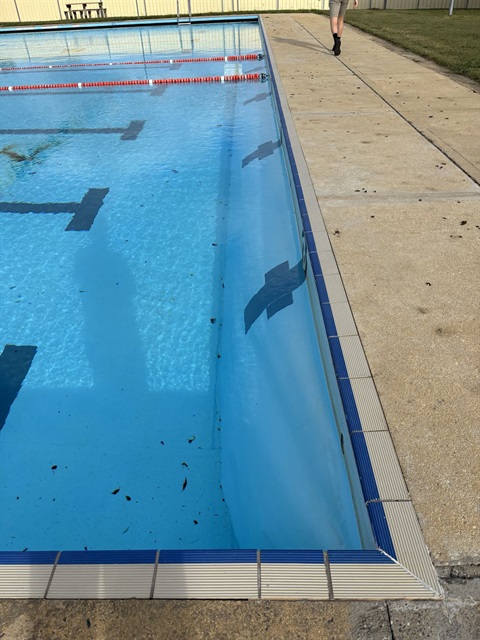Beaufort Pool closure update – Thursday 13 February
Published on 13 February 2025

Image: taken this week at the deep end of the Beaufort pool showing the liner bulging, which has been caused by a significant amount of water collecting behind it.
Pyrenees Shire Council CEO Jim Nolan has provided an update on the closure of the Beaufort Swimming Pool this week, saying that the current problems with the pool’s liner is likely to be a symptom of other issues.
Mr Nolan said that in previous seasons, air has collected behind the pool liner causing a relatively minor bulge only affecting an isolated section, but this time, a significant volume of water has collected behind the liner on all four sides of the pool. It is not unusual for a pool liner to bubble and crease as it ages, but the current issue is unprecedented according to experts consulted by Council.
In the off season, Council had undertaken a range of research and physical works to resolve the cause of the air pocket.
This included removal of the liner, a review and assessment of concrete density and capacity, a geotechnical site investigation, repair to a return feed connection point and installation of hydrostatic valves on the base of the pool, which allows ground water pressure to be released.
Mr Nolan said due to the specialist nature of the current issue, Council has sought expert advice from professionals as a matter of urgency and hopes to be in a position to provide more information once they have assessed the pool.
“We know it’s frustrating but at this early stage of investigation, it’s very difficult to provide the community with more detailed information about the causes and what happens next. But I assure everyone that Council officers are doing everything they can to get to the bottom of the problem and find a way forward.
“It is a complex process to find the cause – if it was a car, we could pop the bonnet, see all the parts and identify the issue quickly. In the case of an outdoor swimming pool where most of the infrastructure is underground in locations not accessible without emptying the pool, it’s not that simple.”
Mr Nolan explained that the pool would remain closed whilst contractors review site safety and repair options in the interests of public safety, which is the most important thing.
“It is not possible to cordon off parts of the pool and allow people to use certain sections as the issue impacts the entire pool,” he said.
“As we don’t know the cause of the issue and the experts say it’s an unprecedented situation, we simply cannot risk the safety of our community as we don’t know what might happen. As a result, we cannot provide a timeframe for potential reopening however we are working towards providing every opportunity to get the pool to reopen this summer.
“Both Council and Belgravia Leisure sincerely apologise for the closure, however the safety of our community is of the utmost importance and must come first.”
Mr Nolan said the Beaufort pool – built in 1967 – is an ageing asset that is coming to the end of its life. This means that unforeseen problems are much more likely to occur, especially when the pool is fully operational during the summer months.
Many Councils around the state and country are facing the same issues with swimming pools as many were built in the 1960s and 1970s to standards and specifications that have long since been improved.
According to a report by Royal Life Saving Australia, the average lifespan of a public pool in Australia is around 50 years. The report states around 40% of public pools will reach the end of their functional lifespan by 2030, meaning they will need significant refurbishment or replacement within the next decade (based on the average Australian public pool being built in 1968).
Mr Nolan assured the community that Council and Belgravia Leisure were doing everything they can to investigate the issue and provide residents with more information and clarity around the much-loved asset.
“The challenges with our pools are many – ageing infrastructure requires more maintenance and a greater likelihood of problems arising during the season. Plus, operational costs for Pyrenees pools have doubled in the past five years.
“While we don’t want to see any of our pools close, we also need to make sure that our services and our pools are safe and delivering what our community needs and expects in a way that’s cost effective and efficient.”